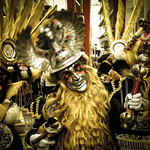For the food
French Guyana might have the cuisine by the same name, beyond a doubt Peru has the best food on the continent; a mix of native, Spanish and East Asian cuisine has generated a combination that’s finger licking good.
Then, in Lima, the somewhat grubby but still decidedly colonial, and very enjoyable, inner city makes for a grand backdrop to a few nights on the town. Sadly, most tourists seek the perceived sterile safety of one of the barrios in the south, hugging the coast, where you’d easily confuse the hipster-infused suburbs for anyplace.
Though there, too, the food is great, if he prices perhaps less so.
Like the vast majority of major cities in Latin America, Lima has only just started to design and build a comprehensive, centralized, public transport system. As a consequence, getting to and from the airport is still quite a hassle, though a metro is set to connect the airport with the rest of the city in 2019.
Natalia and I were spending two weeks in Peru, after which my plan was to head to Panama to cross the Darien gap, separating Panama and Colombia. Once one country, until the US decided they wanted more control over the region that was going to host the Panama Canal.
As a result, my journey into Lima was more convoluted: São Paulo to Rio to Panama City to Lima.
Natalia, who got a direct flight to Lima, was waiting for me on arrival, and we got a taxi into town. A few days before, a building close to the center had completely burned down, killing four people, two of which were locked inside, with, now, the fire brigade blocking off several nearby streets.
Traffic in Lima can be pretty horrendous, but, now, large parts of the city were in utter gridlock. We were stuck in one spot for nearly an hour, and though we had decided to walk the remaining two kilometers, the driver had no intention of letting us go.
Not because he wanted to make a buck, we paid a fixed fee at the airport before leaving, but because he thought the center too dangerous for us.
Eventually, we managed to convince him we’d be alright and would not hold him responsible if anything happened to us. We walked the remaining few kilometers, famished, sampling a bunch of street foods on the way.
The next day, we walked into a long and tumultuous celebration of the day’s patron saint, San Pedro. More like a carnival parade, the most striking features were the rattlers stuffed inside teddybears and the costumes lampooning the conquistadores.
The night before, on a short stroll through town, one church had a queue snaking back and forth on its courtyard, with perhaps a few thousand people, all waiting in line to touch the statue of San Judas Tadeo. They had made a wish and a promise and were now back to thank the saint.
A new addition to the city since my previous visit, were the gambling halls, with slot machines only. The Peruvian economy is doing well, so this could suggest the Chinese are taking over. Last time, I also completely missed the China town almost right next to the hotel we are staying at, the same I stayed at last time.
Pachac qamaq sleeps with the fishes
There are several pyramids within the city limits of Lima. We went to one on the outskirts, a huge complex called Pachacamac. Mr. Qamaq was a local deity who was incorporated into the Inca pantheon when the latter conquered the littoral, the coast.
One legend has it that Pachac Qamaq created the first man and woman but forgot to feed them. After the man died, the woman sought help with the supreme deity, going over Pachac’s head, asking Inti to make her the mother of all the peoples of earth. Pachac was pissed and, one by one, as the children were born, he tried to kill them, only to be beaten and thrown into the sea by the woman’s hero-son. Giving in to his fate, Pachac gave up the struggle and contented himself by becoming the god of fishes.











































